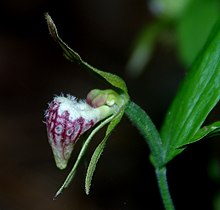Cypripedium arietinum
| Cypripedium arietinum | |
|---|---|

| |
| Scientific classification | |
| Kingdom: | Plantae |
| Clade: | Tracheophytes |
| Clade: | Angiosperms |
| Clade: | Monocots |
| Order: | Asparagales |
| Family: | Orchidaceae |
| Subfamily: | Cypripedioideae |
| Genus: | Cypripedium |
| Species: | C. arietinum
|
| Binomial name | |
| Cypripedium arietinum R.Br. (1813)
| |
| Synonyms | |
| |
Cypripedium arietinum, the ram's head lady's slipper,[2] is a rare terrestrial orchid that grows in lightly to heavily shaded areas with calcareous soils. It is characteristic of the alvars around the Great Lakes in North America].[2][3] In Canada, it is found from Quebec to Saskatchewan, plus an isolated population in Nova Scotia, where it grows on gypsum based soils, 330 km away from the nearest population in Maine.[4][5]

Description
[edit]Cypripedium arietinum is a herbaceous perennial small lady's slipper growing to 10–40 cm (4–16 in). It typically has 3, but sometimes 4-5, leaves and normally has a single flower per flowering stem but in the form biflorum there may be two flowers per stem.[6] The purplish-red flower has light venation and is white at the lip. The flower has three petals, one modified into a densely hairy pouch with white and purplish markings. The sepals are green with reddish-brown markings and the side sepals are to some degree spirally twisted, linear to linear-lanceolate in shape, and are free, in contrast to other North American species in this genus.[7] The other sepal is broadly elliptic to ovate-lanceolate in shape. It flowers in May and June. The diploid (2n) chromosome count is 20.[6]
Distribution and habitat
[edit]While populations of Cypripedium arietinum are declining elsewhere in eastern North America, the orchid flourishes abundantly in Anticosti Island, making the island a refuge for this plant.[8]
Cypripedium arietinum is a forest understory species, it occurs in coniferous to mixed forests and in bogs dominated by Thuja occidentalis (northern white cedar), Larix laricina (tamarack), or Picea mariana (black spruce) where it grows on small mounds produced by Sphagnum mosses.[7] In Minnesota, it more commonly occurs in upland forests dominated by coniferous tree species such as Pinus resinosa (red pine) or Pinus banksiana (jack pine) in weakly acidic (or nearly neutral) soils composed of either loam or clay, it is also found in sandy soils.[7] In northern New England, it often is found in mixed hardwood and softwood forests. [9]
Conservation
[edit]Cypripedium arietinum is considered rare to extremely rare in all locations where it occurs.[4] More specifically, it is rare in Ontario[10] and rare in Manitoba. The ram's head lady's slipper is a threatened plant species in other areas within its range, including Wisconsin, Minnesota, Michigan, and Saskatchewan. It is believed to be extirpated in Connecticut. This species is listed as an endangered species in Nova Scotia.[11]
The ram's head lady's slipper is difficult to cultivate and rarely survives transplantation to a garden from the wild. It should never be removed from any natural area.
Conservation efforts of Cypripedium arietinum in New England have been advancing with the optimization of asymbiotic sterile seed germination and sterile seedling cultures. This research is being presented and published in the 2024 World Orchid Conference in Taiwan and in the Orchid Digest. [12]
References
[edit]- ^ Ames, D., P. B. Acheson, L. Heshka, B. Joyce, J. Neufeld, R. Reeves, E. Reimer, and I. Ward. 2005. Orchids of Manitoba: A field guide. Native Orchid Conservation Inc., Winnipeg.
- ^ a b USDA, NRCS (n.d.). "Cypripedium arietinum". The PLANTS Database (plants.usda.gov). Greensboro, North Carolina: National Plant Data Team. Retrieved 1 July 2016.
- ^ Catling, P.M.; Brownell, V.R. (1999). "Alvars of the Great Lakes Region". In Anderson, R. C.; Fralish, J. S.; Baskin, J. M. (eds.). Savannas, Barrens and Rock Outcrop Communities of North America. Cambridge: Cambridge University Press. pp. 375–391. ISBN 9780511574627.
- ^ a b Blaney, S.; Mazerolle, D. (2007). Nova Scotia Provincial Status Report on Ram's-Head Lady Slipper (Cypripredium arietinum R. Br.). Nova Scotia Department of Natural Resources.
- ^ "Cypripedium arietinum". County-level distribution map from the North American Plant Atlas (NAPA). Biota of North America Program (BONAP). 2014.
- ^ a b "Cypripedium arietinum in Flora of North America @ efloras.org". www.efloras.org. Retrieved 2020-12-11.
- ^ a b c Barbara Coffin; Lee Pfannmuller (1988). Minnesota's Endangered Flora and Fauna. U of Minnesota Press. p. 84. ISBN 978-0-8166-1689-3.
- ^ "Cypripedium arietinum Ait. f." North American Orchid Conservation Center. 2011. Retrieved 30 July 2024.
...has a limited distribution across northeastern and central Canada and the U.S., from Quebec to Wisconsin.
- ^ Lan Grace, Palifka Nicholas, Sun Ian, Sun Kevin, Anderson Kastner. (2024). Conservation of the Cypripediums of New England. Orchid Digest, Vol. 88-2, Apr., May, June. (in print)
- ^ Oldham, M.J.; Brinker, S.R. (2009). Rare Vascular Plants of Ontario (4th ed.). Peterborough, Ontario: Natural Heritage Information Centre, Ontario Ministry of Natural Resources.
- ^ "Species at Risk Overview". Nova Scotia Department of Natural Resources. Retrieved 15 July 2018.
- ^ Lan Grace, Palifka Nicholas, Sun Ian, Sun Kevin, Anderson Kastner. (2024). Conservation of the Cypripediums of New England. Orchid Digest, Vol. 88-2, Apr., May, June. (in print)
External links
[edit] Media related to Cypripedium arietinum at Wikimedia Commons
Media related to Cypripedium arietinum at Wikimedia Commons Data related to Cypripedium arietinum at Wikispecies
Data related to Cypripedium arietinum at Wikispecies
- IUCN Red List near threatened species
- NatureServe vulnerable species
- Cypripedium
- Orchids of Canada
- Orchids of the United States
- Flora of Maine
- Flora of Manitoba
- Flora of Michigan
- Flora of Minnesota
- Flora of Nova Scotia
- Flora of Ontario
- Flora of Saskatchewan
- Flora of Wisconsin
- Taxa named by Robert Brown (botanist, born 1773)


